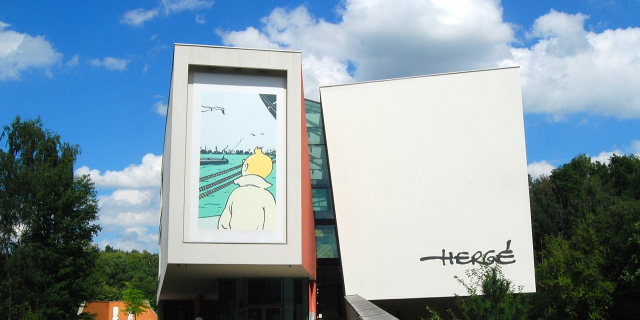Royal Greenhouses of Laeken
The Royal Greenhouses of Laeken (French: Serres Royales de Laeken, Dutch: Koninklijke Serres van Laken) are a vast complex of monumental heated greenhouses in the park of the Royal Palace of Laeken (northern part of the City of Brussels), Belgium. The historic complex contains tropical, subtropical and cold greenhouses, and is home to the famous Royal Botanic Collection, which includes large collections of camellias, orange trees and many plants originating from the African parts of the former Belgian Empire.
The greenhouses were commissioned by King Leopold II, originally designed by the architect Alphonse Balat, and built between 1874 and 1905. Following Balat's death in 1895, Leopold called upon the architects Henri Maquet and Charles Girault. They are now part of the Royal Domain and the royal private gardens belonging to the Belgian royal family, and are accessible to the public only a few days a yea...Read more
The Royal Greenhouses of Laeken (French: Serres Royales de Laeken, Dutch: Koninklijke Serres van Laken) are a vast complex of monumental heated greenhouses in the park of the Royal Palace of Laeken (northern part of the City of Brussels), Belgium. The historic complex contains tropical, subtropical and cold greenhouses, and is home to the famous Royal Botanic Collection, which includes large collections of camellias, orange trees and many plants originating from the African parts of the former Belgian Empire.
The greenhouses were commissioned by King Leopold II, originally designed by the architect Alphonse Balat, and built between 1874 and 1905. Following Balat's death in 1895, Leopold called upon the architects Henri Maquet and Charles Girault. They are now part of the Royal Domain and the royal private gardens belonging to the Belgian royal family, and are accessible to the public only a few days a year. This site is served by Stuyvenbergh metro station on line 6 of the Brussels Metro.
The original gardens of the Royal Palace of Laeken date back to the 18th century, but King Leopold II drastically changed their appearance. The king, having visited the Crystal Palace at the Great Exhibition of 1851 in London, wanted such a progressive building in his palace's garden, which would combine his love for plants with multifunctional spaces that could also be used as a banquet, theatre and dining halls. He called on the botanist Jean Linden for this project, but his design was too unambitious. He then commissioned his architect Alphonse Balat. Balat's plans surpassed all that had been achieved at the time, even the Palm house in London's Kew Gardens (1844–1848) and Carl Bouché's botanical garden in Berlin-Schöneberg. The realisation came about in close consultation between Balat and the king, following frequent discussions, correspondence and preliminary designs.[1]
 Winter Garden of the Royal Greenhouses of Laeken in 1880, etching from L'Illustration nationale[2]
Winter Garden of the Royal Greenhouses of Laeken in 1880, etching from L'Illustration nationale[2]The first construction phase took place between 1874 and 1893, ending with the completion of the so-called Iron Church, a domed greenhouse, which would originally serve as the royal chapel. The inauguration took place in 1880, but the complex was also expanded afterwards.[3] During that period, the king was preparing his Congo Free State, a private colony which was founded in 1885. The greenhouses were intended as a symbol of the king's colonial power: plants from Central Africa were said to illustrate that power. In particular, the Congo Greenhouse and the Embarcadère Greenhouse were built in 1886–1888 from this perspective. A third zone was constructed from 1892 to 1905. For this, following Balat's death in 1895, Leopold called upon the architects Henri Maquet and Charles Girault. The octagonal Palm Pavilion was furnished as a bedroom and connected to the palace by a subterranean corridor where Leopold received his mistresses.[4] After the king's death in 1909, the greenhouses were preserved, but the Iron Church was converted into a private royal bathing house.
Present-day The Dancing Solar Forget-Me-Not (for Child Focus), Alexandre Dang, exhibit in the Royal Greenhouses
The Dancing Solar Forget-Me-Not (for Child Focus), Alexandre Dang, exhibit in the Royal GreenhousesThe Winter Garden at the palace in Laeken still serves as the setting for royal receptions. Every year in the spring, the greenhouses are partially opened to the public for twenty days at the request of Leopold II. This tradition has been carried on by all monarchs who reigned after him.[1] The greenhouses are also sometimes used today for contemporary art exhibits and displays, such as Alexandre Dang's The Dancing Solar Forget-Me-Not for the International Day of Missing Children (in cooperation with Child Focus) in 2010.
Since 2021, a new heating system for the Royal Domain of Laeken has come into operation: the new network is directly connected to the Neder-Over-Heembeek incinerator via 4.5 km (2.8 mi) of underground pipes allowing the residual heat released by the incinerator to be exported to the Royal Domain and thus heat the greenhouses and buildings.[5][6]
































Add new comment